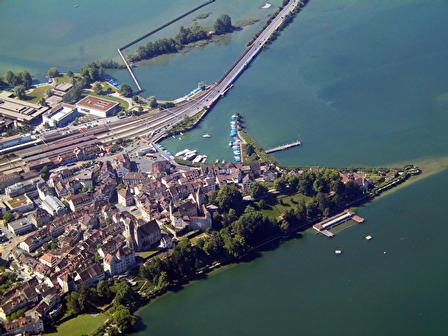|
Bollingen
Bollingen is a village (''Kirchdorf'') within the municipality of Rapperswil-Jona in the Swiss canton of St. Gallen. Geography The village is located along the northern shore of the upper Lake Zürich (''Obersee'') between Jona and Schmerikon. Bollingen was part of the former municipality of Jona: On 1 January 2007 the former municipalities of Rapperswil and Jona merged to form the new political entity Rapperswil-Jona. History Sandstone from Bollingen may have been used even in the Roman Empire era, but presumably ''Bollinger Sandstein'' is extracted and processed since 1000 AD. Among others it was used for the Grossmünster and Fraumünster churches in Zürich, as well as for the Einsiedeln and St. Gallen abbeys, or the Zunfthaus zur Meisen that was built in 1757 at the Münsterhof plaza in Zürich. In the European Middle Ages, the two settlements named ''Unterbollingen'' and ''Oberbollingen'' are mentioned as part of the later Herrschaft Rapperswil of the Counts of Rapp ... [...More Info...] [...Related Items...] OR: [Wikipedia] [Google] [Baidu] |
Obersee (Zürichsee)
The Obersee ("upper lake") is the smaller of the two parts of '' Zürichsee'' (Lake Zürich) in the cantons of St. Gallen and Schwyz in Switzerland. Geography ''Zürichsee'' is the common name for the ''lower'' (''Untersee'') northwestern section of , while the smaller southeastern ''upper'' (''Obersee'') lake area measures , separated by the Seedamm causeway, a Molasse formation connecting Rapperswil with the Hurden peninsula. Before 1951 the annual water level fluctuated more than , but since then the water level is strictly regulated and therefore between summer and winter differs an average of . The average lake level is now at 406 metres above sea level, while ''Obersee'' and ''Untersee'' differ by only . The ''Seedamm'' between Rapperswil and Hurden was used since about 5,000 years as a historical lake crossing. Since the 1870s a partially artificial road causeway and two bridges were added, to cross the most narrow and flatbedded area of the lake, carrying ... [...More Info...] [...Related Items...] OR: [Wikipedia] [Google] [Baidu] |
Bollinger Sandstein
Bollinger Sandstein or Bollingen Sandstone is a sandstone found on Obersee lake shore, namely between Bollingen and Uznach and Buechberg area, in the cantons of St. Gallen and Schwyz in Switzerland. Geography The sandstone is found on Obersee (upper Lake Zürich) northeastern shore, namely between Bollingen and Uznach and on the other side of the lake at the Buechberg area, in the Swiss cantons of St. Gallen and Schwyz. Description Depending on the layer, the appearance and texture of the natural stone also varies, therefore distinct names have developed at the different mining locations: ''Güntliweid'' sandstone means a darker, coarse-grained portion of the deposit. The '' Buechberg'' variant has a bit brighter colour, while the ''Uznaberg'' sandstone is bright and even fine-grained. In addition to these names, the ''Bollinger-Brand'' sandstone is mined in Eschenbach SG and the ''Bollinger-Lehholz'' sandstone is mined between Jona and Bollingen. The Bollingen s ... [...More Info...] [...Related Items...] OR: [Wikipedia] [Google] [Baidu] |
Bollingen Tower
The Bollingen Tower is a structure built by Swiss psychiatrist Carl Jung. In appearance, it is a small castle with four towers. It is located in the village of Bollingen on the shore of the ''Obersee'' (upper lake) basin of Lake Zürich. History Jung bought the land in 1922 after the death of his mother. In 1923 he built a two-storey round tower on this land. It was a stone structure suitable to be lived in. Additions to this tower were constructed in 1927, 1931, and 1935, resulting in a building that has four connected parts. A second storey was added to the 1927 addition after the death of Jung's wife in 1955, signifying "an extension of consciousness achieved in old age." For much of his life Jung spent several months each year living at Bollingen. The Tower is now owned by a family trust and is not open to the public. The Bollingen Foundation, created in 1945 but inactive since 1968, was named after it. Inscribed cube In 1950, on the occasion of his 75th birthday, ... [...More Info...] [...Related Items...] OR: [Wikipedia] [Google] [Baidu] |
Rapperswil-Jona
Rapperswil-Jona is a municipality in the ''Wahlkreis'' (constituency) of See-Gaster in the canton of St. Gallen in Switzerland. Besides Rapperswil and Jona, which were separate municipalities until 2006, the municipality includes Bollingen, Busskirch, Curtiberg, Kempraten-Lenggis, Wagen, and Wurmsbach. The official language of Rapperswil is (the Swiss variety of Standard) German, but the main spoken language is the local variant of the Alemannic Swiss German dialect. Today On January 1, 2007, the municipalities of Rapperswil and Jona merged to form a new political entity.Amtliches Gemeindeverzeichnis der Schweiz published by the Swiss Federal Statistical Office accessed 23 September 2009 After the merger Rapperswil-Jona had a population of 25,7 ... [...More Info...] [...Related Items...] OR: [Wikipedia] [Google] [Baidu] |
Jona, Switzerland
Jona is a former municipality and since January 2007 part of the municipality of Rapperswil-Jona in the ''Wahlkreis'' ( constituency) of See-Gaster in the canton of St. Gallen in Switzerland. Before the merger with Rapperswil, the former municipality of Jona comprised the villages of Jona, Bollingen, Busskirch, Curtiberg, Kempraten-Lenggis, Wagen and Wurmsbach ( Wurmsbach Abbey). Geography The former municipality of Jona extended from the eastern shore of the main part of Lake Zürich (Kempraten) to the northern shore of ''Obersee'', the upper or eastern division of Lake Zurich ( Bollingen, Busskirch, Wurmsbach). The former village of Jona is located on the River Jona, which flows into the ''Obersee''. History The River Jona flows through the former Jona municipality in the ''Obersee'' (upper Lake Zürich). The settlement is named after the river, first recorded in Latinized form ''Johanna'' in AD 834, as ''super Johannam fluvium''. The Middle High German form '' ... [...More Info...] [...Related Items...] OR: [Wikipedia] [Google] [Baidu] |



